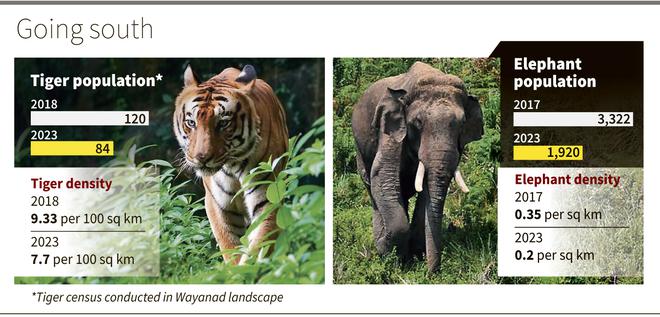The population of wild tuskers in Kerala and that of tigers in the Wayanad landscape have declined over the last five years, the latest wildlife census has shown.
Forest Minister A.K. Saseendran, who presented the findings of enumerations undertaken by the Forest department here on Friday, said the tiger population in Wayanad had come down to 84 from 120 in 2018, while that of elephants had fallen to 1,920, down from 3,322 in 2017.
The studies have disproved the presumption that the population of such animal species exceeded the carrying capacity of forests. Such speculations triggered by multiple instances of wild animal attacks on humans, particularly in Wayanad, had necessitated the census. The findings also corroborated the Status of Tigers 2022 report released by the National Tiger Conservation Authority.
‘No need for concern’
At the same time, forest authorities maintained that the fall in numbers did not warrant concern as such trends could be influenced by wildlife migration patterns along State borders and vagaries of the weather.
The tiger census was conducted in the Wayanad landscape comprising the wildlife sanctuaries of Wayanad, Aralam and Kottiyoor and the forest areas adjoining Karnataka in the forest divisions of South Wayanad, North Wayanad, and Kannur from April 10 and May 25. A total of 297 camera traps were installed at various locations, including 50 outside the enumeration area, to record the presence of tigers.
Tiger density falls
Tiger density has fallen from 9.33 per 100 sq km to 7.7 per 100 sq km. Out of the 84 tigers that were detected, 69 were from the Wayanad Wildlife Sanctuary, eight from the North Wayanad division and seven from the South Wayanad division.
As many as 45 tigers of those spotted in the census had been observed in studies conducted in 2022, 2018 and 2016. Foresters have identified 29 males and 47 females among the lot, thereby recording a sex ratio of 1.62 female tigers for each male tiger. The gender of the remaining eight tigers is yet to be ascertained.
From May 17 to 19
The elephant enumeration was conducted from May 17 to 19 to coincide with similar exercises undertaken in other south Indian States — Tamil Nadu, Karnataka, Andhra Pradesh, Telangana and Goa. The 2017 census too was conducted on the same days.
The block count and dung count methods were employed for the exercise. During the block count, 251 elephant herds comprising 700 elephants were recorded to peg the wild elephant estimate in the State at 1,920. The dung count method estimated the count at 2,386. The corresponding counts during the 2017 census were 3,322 and 5,706 respectively.
Both methods also revealed a fall in elephant density – from 0.35 per sq km to 0.2 per sq km according to the block count method and 0.59 per sq km to 0.25 per sq km as per the dung count method.

Climate’s role in numbers
Suggesting climate could have played a significant role in elephant migration, Head of Forest Force Bennichen Thomas said elephants had migrated to Kerala in large numbers during the 2017 census when dry weather prevailed in Karnataka. During the latest census, Kerala witnessed a considerable spike in temperature while it rained in the bordering parts of Karnataka.







